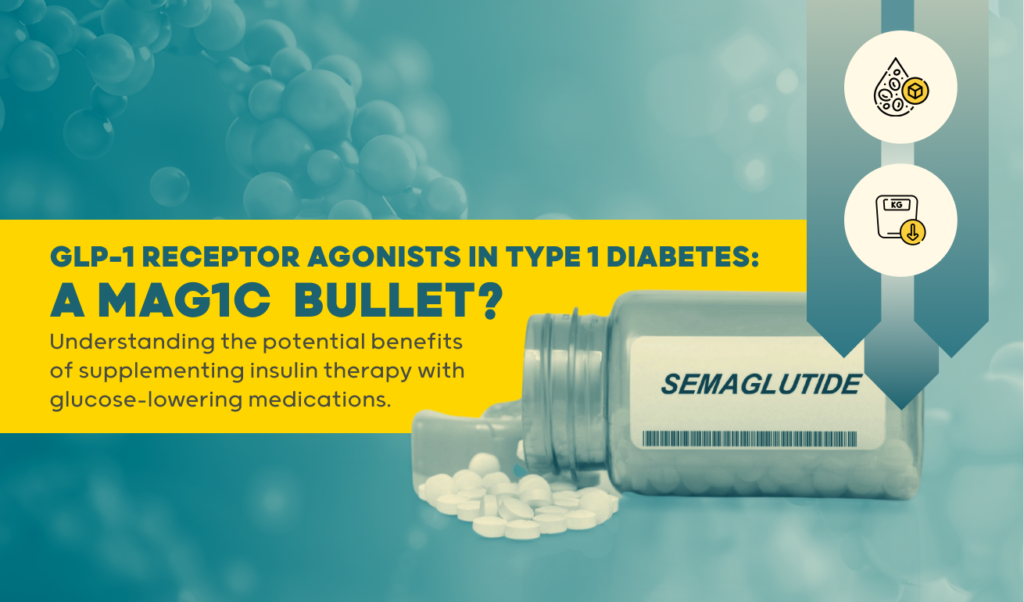GLP-1 receptor agonists in Type 1 Diabetes: A MAG1C bullet?
Published Date:
February 28, 2020
Approved By:
TO BE
Decoded By:
Asra H. Ahmed
MBA, PGCE in Assessment Learning disability, Diabesties Foundation.
10 mins to read
- The T1D Takeaway
- Is MAG1C really a “Magic Bullet” that can help people living with type 1 diabetes? I think we just found something! Any big or small steps to help reduce weight, slow down blood sugar variability, and mitigate kidney disease… is a WIN in my books.
Word Wizard
- The primary treatment for high blood sugar levels is insulin injections. However, researchers continually study the potential benefits of supplementing insulin therapy with glucose-lowering medications such as Metformin, Amylin analogues, SGLT2 inhibitors, and GLP-1 receptor agonists.
- The MAG1C study, conducted by Nicklas Johansen and colleagues and reported in The Lancet, focused on investigating the effects of adding a GLP-1 receptor agonist to insulin therapy specifically in people living with type 1 diabetes.
- It reported Minor reductions in HbA1c and other measures of glycemic control.No significant increase in the risk of hypoglycemia reported.
- No occurrence of ketoacidosis during the trial.
- Substantial body weight reduction, averaging 4.4 kg.
- Adverse events reported after commencing GLP-1 receptor agonists included nausea, vomiting, and diarrhea.
- The delicate balance between insulin dose reduction and exposure to GLP-1 receptor agonists may explain the minor effects on blood sugar numbers observed in the study.

Summary Snap
Shots
The study showed minor improvements in glycemic control, no significant increase in hypoglycemia risk, substantial weight reduction. However, common gastrointestinal side effects such as nausea, vomiting, and diarrhea were also reported. Study design challenges regarding the use of protein metabolism application in diabetic kidney disease were also discussed.
Prime Insight
The MAG1C study investigated the effect of adding a GLP-1 receptor agonist alongside multiple daily insulin injections in people with type 1 diabetes.
GLP-1 receptor agonists stimulate insulin secretion, suppress glucagon, slow gastric emptying, suppress appetite, and induce weight loss.
ADDING A GLP-1 RECEPTOR AGONIST TO INSULIN THERAPY IN TYPE 1 DIABETES MAY OFFER BENEFITS, INCLUDING IMPROVED GLYCEMIC CONTROL AND WEIGHT MANAGEMENT. HOWEVER, WHILE THESE BENEFITS ARE PROMISING, THEIR WIDESPREAD USE CANNOT BE JUSTIFIED WITHOUT CAREFULLY EVALUATING INDIVIDUAL PATIENT RESPONSES.

Minor reductions in HbA1c and other glycemic control measures were observed without a significant increase in hypoglycemia risk.
A significant reduction in body weight was noted, potentially more pronounced in people with type 1 compared to those with type 2 diabetes.
Interaction between insulin and GLP-1 agonists complicates glycemic control, requiring adjustments in insulin doses and injection timing. Thus, a need for continuous glucose monitoring is essential.

Study design challenges included high dropout rates and fewer high-risk participants than expected, which affected study power.
It’s still hard to afford to conduct a large-scale study with large samples to assess the effects on all proteins, however, this would be needed to validate and apply the results from this study. Particularly when discussing diabetes-related complications including kidney disease.
Successful treatment depends on patient education and a continuous tight interaction between patients, physicians, nurse instructors, and dieticians.
This study shows how combining proteins, genes, and metabolic products could improve personalized care strategies and screening outcomes for people with type 1 diabetes.
Successful management of type 1 diabetes requires education and collaboration among patients, healthcare providers, and specialists.
- A Deeper Dive
- To learn more about recent discoveries of GLP-1 receptor agonists and GLP-2 receptor agonists on glucagon counter regulation in type 1 diabetes.
- Investigate the impact of a dual GLP-1/glucagon receptor agonist on postprandial glucose excursions in individuals with type 1 diabetes
- The role of GLP-1 receptor agonists in the management of Type 1 Diabetes: unravelling the complex mechanisms of action.
- The Sources Voice
In the case of MAG1C, a GLP-1 receptor agonist, it may reduce glycaemia. Whereas the compensatory dose reduction in (prandial) insulin will support (transient) rises in plasma glucose concentrations. The delicate balance between both effects might explain the overall minor effects on glycaemia (HbA1c) seen with adjunct glucose-lowering medications,1 including GLP-1 receptor agonists.
- Curiosities Clarified
The study provided insights into the effects of adding GLP1 agonist to multiple daily insulin injections by people living with type 1 diabetes, including its impact on measures of glycemic control, hypoglycemia risk, and body weight.
The study discussed challenges related to study design, particularly regarding the use of protein metabolization and validation. It also discussed its application in diabetic kidney disease, however, more research would be recommended to truly understand this relationship.
